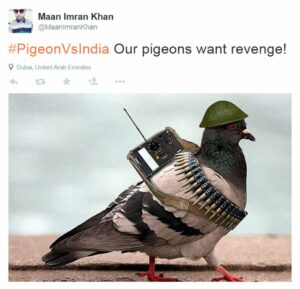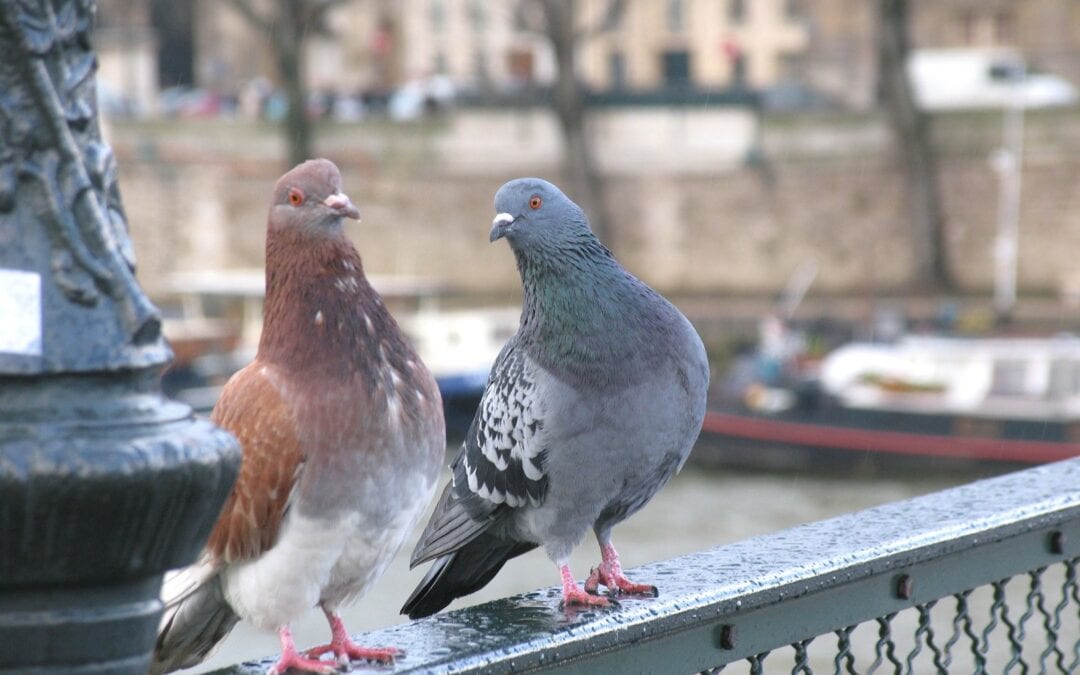
by Pigeon Patrol | Oct 17, 2023 | Bird Spike, Pigeon Spikes, Pigeons, Pigeons in the News, Raccoons, Sparrows, UltraSonic Bird Control
Scientists found that attaching small weights to pigeons causes them to shoot up in the social hierarchy. The finding is important because scientists often attach trackers to pigeons.
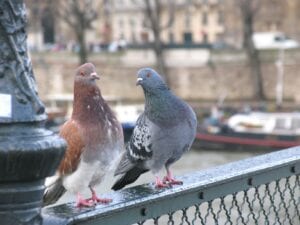
Now a story about what happens when you turn society upside down – specifically, pigeon society.
It turns out there is a social hierarchy among pigeons, and it definitely pays to be the big bird on campus.
Being top of the dominance hierarchy basically gives you preferential access to everything. It means you get priority access to food, priority access to mates.
That’s Steve Portugal, a zoologist and biologist at Royal Holloway, University of London. And contrary to what you may have heard about the early bird getting the worm, in the case of pigeons, it is heavier birds that get all the perks.
So Portugal and his colleagues wondered what would happen if you made lighter pigeons feel heavier. If you beefed them up, would they punch above their weight?
They tested their theory in a captive flock of homing pigeons. They identified the birds in the bottom half of the hierarchy and loaded them up with tiny weights – little bird backpacks, actually.
And sure enough, when I did that, they became much more aggressive, started much more fights and won many more fights as well.
The former head honcho pigeons took notice.
What was fascinating just to sort of watch anecdotally was, you know, they could see that they were a bit like, what’s going on? You know, what’s happening? We’re being sort of – there’s a military coup, almost, against us.
Apparently, they fought back at first. But eventually, among the males, the birds with the little backpacks prevailed.
The researchers say the extra weight might have made the lighter pigeons feel like they were in better shape, like they had more energy to burn picking fights.
Or perhaps they just hunted for food more aggressively than usual because, you know, strutting around with weights meant burning more calories and needing more food. The findings appear in the journal Biology Letters.
Portugal says this research is important because scientists often attach tiny trackers to pigeons and other animals, and that adds extra weight.
They might not be physiologically impeded by them, but they – it might be having an impact on their social structure, their social networks, their group dynamics.
As for the pigeons in this study, once the backpacks came off, the old pecking order snapped right back into place. The lightweights were back to scratching out a living at the bottom of the heap.
Source
Pigeon Patrol
Pigeon Patrol Products & Services is the leading manufacturer and distributor of bird deterrent (control) products in Canada. Pigeon Patrol products have solved pest bird problems in industrial, commercial, and residential settings since 2000, by using safe and humane bird deterrents with only bird and animal -friendly solutions. At Pigeon Patrol, we manufacture and offer a variety of bird deterrents, ranging from Ultra-flex Bird Spikes with UV protection, Bird Netting, 4-S Bird Gel and the best Ultrasonic and audible sound devices on the market today.
Canada’s top wholesaler for bird deterrent products for twelve consecutive years.
Contact us at 1- 877– 4– NO-BIRD, (604) 585-9279 or visit our website at https://www.pigeonpatrol.ca/
Bird Gone, Pigeon Gone, Pigeon problems, pigeon spikes, 1-877-4NO-BIRD, 4-S Gel, Bird Control, Pigeon Control, bird repellent, Bird Spikes, sonic bird repellent, stainless steel bird spikes, bird spikes Vancouver, Ultra Sonic Bird Control, Bird Netting, Plastic Bird Spikes, Canada bird spike deterrents, Pigeon Pests, B Gone Pigeon, Pigeon Patrol, pest controller, pest control operator, pest control technician, Pigeon Control Products, humane pigeon spikes, pigeon deterrents, pigeon traps, Pigeon repellents, Sound & Laser Deterrents, wildlife control, raccoon, skunk, squirrel deterrent, De-Fence Spikes, Dragons Den, Pigeon, Pigeon Patrol, Pigeons Roosting, Vancouver Pigeon Control, Bird Spikes, Bird Control, Bird Deterrent, Pigeon Deterrent, Surrey Pigeon Control, Pest, Seagull deterrent Vancouver Pigeon Blog, Birds Inside Home De-fence, Pigeon Nesting, Bird Droppings, Pigeon Dropping, woodpecker control, Keep The Birds Away, Birds/rats, seagull, pigeon, woodpecker, dove, sparrow, pidgeon control, pidgeon problem, pidgeon control, flying rats, pigeon Problems, bird netting, bird gel, bird spray, bird nails, bird guard, Pigeon control, Bird deterrents, Pigeon deterrents, Bird control, solutions, Pigeon prevention, Pigeon repellent, Bird proofing, Pest bird management, Pigeon spikes, Bird netting, Humane bird control, Bird exclusion, Urban bird control, Anti-roosting devices, Pigeon removal, Bird barriers
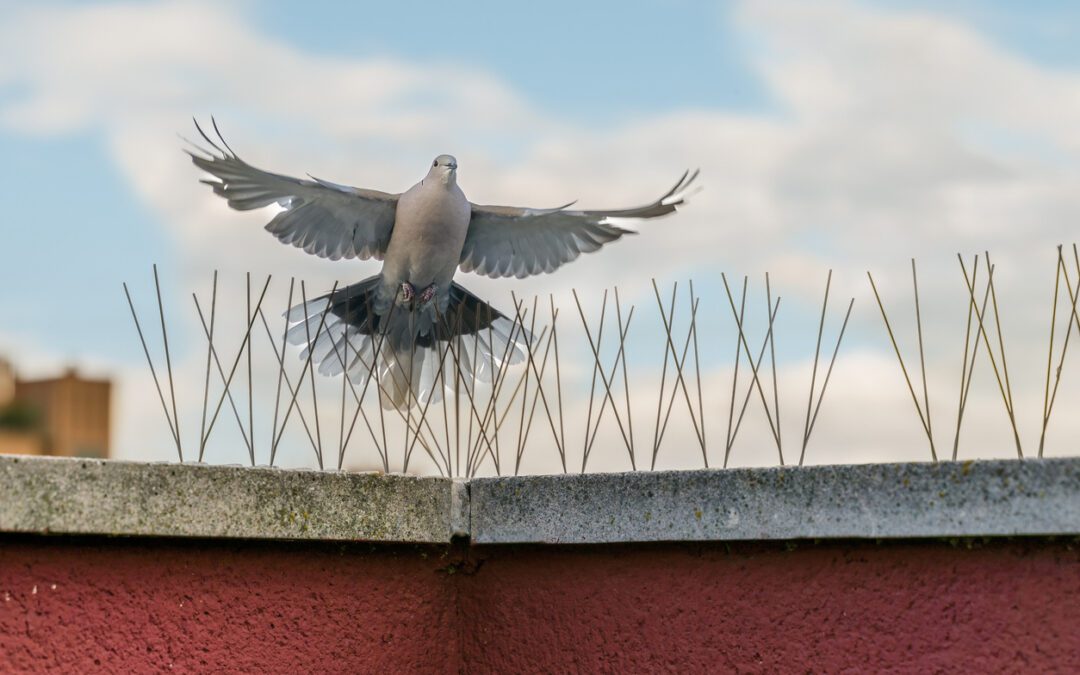
by Pigeon Patrol | Oct 17, 2023 | 4-S Gel Bird repellent, Animal Deterrent Products, Bird Deterrent Products, Bird Law, Bird Netting, Bird Spikes
Psittacosis is an infectious flu-like disease which spreads to humans from infected birds like pigeons. It is caused by the bacteria Chlamydia psittaci.
Though psittacosis appears to be mild in nature, it causes illness and pneumonia or lung infection.
Bird Fancier’s Lung or bird breeder’s lung is a type of hypersensitivity pneumonitis which is caused due to the antigens present in bird droppings.
In this infection, the patient experiences flu-like symptoms like shortness of breath or dyspnea and cough. In many cases, the patient also experiences weight loss, anorexia and extreme weight loss.
When the disease worsens it reduces the lungs’ efficiency over time and leads to pulmonary fibrosis. This can eventually lead to respiratory failure.
In January 2020, two women from Mumbai, aged 38 and 68, underwent lung transplant due to a serious health condition called chronic hypersensitivity pneumonitis which is also called as environment related lung fibrosis.
News reports have said that pulmonologist Unmil Shah and others whom the patients visited over the years found pigeon droppings in the common duct area of their building. One of the patients said her breathing problems started after she moved to her new home.
Pigeon droppings carry over 60 diseases research studies have found.
Pigeon droppings cause respiratory diseases like Histoplasmosis, fungal infection Candidiasis, pulmonary disease called Cryptococcosis which affects the central nervous system at a later stage, St. Louis Encephalitis an inflammation of the nervous system, Salmonellosis or food poisoning, and infections caused by E.Coli present in the bird droppings.
Bird droppings also cause Newcastle disease, a highly contagious disease of birds caused by a paramyxovirus.
Pigeons of the metro cities are well fed. From appeasing celestial bodies to just for fun, metro dwellers love feeding pigeons. This is also the best way to keep the interaction with nature going for those who stay in small congested areas in big cities.
Feeding birds during dawn and dusk is an integral part of metro life.
While maintaining the bare minimum connection with nature is essential and should not be cut down completely, an additional responsibility of discarding the animal wastes is what people need to accept right now.
Those who have got COPD or have asthma allergic problems can develop severe reactions upon exposure to pigeon droppings and their lung conditions can deteriorate, says Dr Rai.
“To stay safe, avoid feeding pigeons so that their population density remains under control. Avoid going to highly risky places where pigeon droppings are. At an individual level, people can keep nets to minimize exposure to pigeon droppings. Those who use ACs should be careful as pigeons tend to remain near it; those areas need to be clear of pigeon droppings,” suggests Dr Rai.
Use a mask to clean pigeon droppings on balconies and windows, he adds.
Since pigeon droppings are known to carry over 60 diseases research studies it is extremely important to keep the surroundings clean, particularly if you have been feeding them for a long time, explains Dr. S.P Rai, Consultant, pulmonary medicine and sleep medicine at Kokilaben Dhirubhai Ambani Hospital, Mumbai.
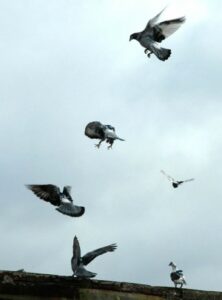
Do not let the droppings accumulate. Use water and a disinfectant to clean the area which is frequented by the avians, he adds.
Source
Pigeon Patrol
Pigeon Patrol Products & Services is the leading manufacturer and distributor of bird deterrent (control) products in Canada. Pigeon Patrol products have solved pest bird problems in industrial, commercial, and residential settings since 2000, by using safe and humane bird deterrents with only bird and animal -friendly solutions. At Pigeon Patrol, we manufacture and offer a variety of bird deterrents, ranging from Ultra-flex Bird Spikes with UV protection, Bird Netting, 4-S Bird Gel and the best Ultrasonic and audible sound devices on the market today.
Canada’s top wholesaler for bird deterrent products for twelve consecutive years.
Contact us at 1- 877– 4– NO-BIRD, (604) 585-9279 or visit our website at https://www.pigeonpatrol.ca/
Bird Gone, Pigeon Gone, Pigeon problems, pigeon spikes, 1-877-4NO-BIRD, 4-S Gel, Bird Control, Pigeon Control, bird repellent, Bird Spikes, sonic bird repellent, stainless steel bird spikes, bird spikes Vancouver, Ultra Sonic Bird Control, Bird Netting, Plastic Bird Spikes, Canada bird spike deterrents, Pigeon Pests, B Gone Pigeon, Pigeon Patrol, pest controller, pest control operator, pest control technician, Pigeon Control Products, humane pigeon spikes, pigeon deterrents, pigeon traps, Pigeon repellents, Sound & Laser Deterrents, wildlife control, raccoon, skunk, squirrel deterrent, De-Fence Spikes, Dragons Den, Pigeon, Pigeon Patrol, Pigeons Roosting, Vancouver Pigeon Control, Bird Spikes, Bird Control, Bird Deterrent, Pigeon Deterrent, Surrey Pigeon Control, Pest, Seagull deterrent Vancouver Pigeon Blog, Birds Inside Home De-fence, Pigeon Nesting, Bird Droppings, Pigeon Dropping, woodpecker control, Keep The Birds Away, Birds/rats, seagull, pigeon, woodpecker, dove, sparrow, pidgeon control, pidgeon problem, pidgeon control, flying rats, pigeon Problems, bird netting, bird gel, bird spray, bird nails, bird guard, Pigeon control, Bird deterrents, Pigeon deterrents, Bird control, solutions, Pigeon prevention, Pigeon repellent, Bird proofing, Pest bird management, Pigeon spikes, Bird netting, Humane bird control, Bird exclusion, Urban bird control, Anti-roosting devices, Pigeon removal, Bird barriers

by Pigeon Patrol | Oct 3, 2023 | Bird Spike, Pigeon Droppings, Pigeon Patrol's Services, Pigeon Predators, Pigeon Spikes, Pigeons
A Thai district chief has clipped the wings of his town’s pigeon population by paying residents to trap the birds and organising a cook-off to build support for the cull.
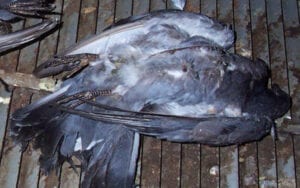
The campaign to go after hundreds of thousands of pigeons started earlier this week in a district of Lop Buri province – a region better known for its monkey menace.
“The number of pigeons increases four to five times each year, if we don’t do anything the problem will get worse,” said Plaek Thepparak, the highest government official in Mueang district, who came up with the idea.
The birds were a nuisance and defecated on government offices, historical sites, temples and houses while ravaging local crops, he added.
“Before people can drink rain water but now they have to buy drinking water because rain water is dirty from bird droppings,” he said.
Residents will get 10 baht (about $0.30) per trapped birds, which will be transferred to a quarantine centre in a nearby province.
But cooking them up is also on the menu.
“We also urged residents to eat the dead pigeons but only if they are hygienic and cook them well,” Plaek said, adding the town hosted a “pigeon menu” cooking competition earlier this week with cash prizes.
The dishes whipped up included a simple fried pigeon, knocked back with a side of Thailand’s classic papaya salad.
Two hours north of the capital Bangkok, Lop Buri is on Thailand’s tourist circuit and is better known as a haven for monkeys, but even they are being outnumbered by the birds.
“There are about 3,000 monkeys but there are hundreds of thousands of pigeon,” Plaek said.
Source
Pigeon Patrol
Pigeon Patrol Products & Services is the leading manufacturer and distributor of bird deterrent (control) products in Canada. Pigeon Patrol products have solved pest bird problems in industrial, commercial, and residential settings since 2000, by using safe and humane bird deterrents with only bird and animal -friendly solutions. At Pigeon Patrol, we manufacture and offer a variety of bird deterrents, ranging from Ultra-flex Bird Spikes with UV protection, Bird Netting, 4-S Bird Gel and the best Ultrasonic and audible sound devices on the market today.
Canada’s top wholesaler for bird deterrent products for twelve consecutive years.
Contact us at 1- 877– 4– NO-BIRD, (604) 585-9279 or visit our website at https://www.pigeonpatrol.ca/
Bird Gone, Pigeon Gone, Pigeon problems, pigeon spikes, 1-877-4NO-BIRD, 4-S Gel, Bird Control, Pigeon Control, bird repellent, Bird Spikes, sonic bird repellent, stainless steel bird spikes, bird spikes Vancouver, Ultra Sonic Bird Control, Bird Netting, Plastic Bird Spikes, Canada bird spike deterrents, Pigeon Pests, B Gone Pigeon, Pigeon Patrol, pest controller, pest control operator, pest control technician, Pigeon Control Products, humane pigeon spikes, pigeon deterrents, pigeon traps, Pigeon repellents, Sound & Laser Deterrents, wildlife control, raccoon, skunk, squirrel deterrent, De-Fence Spikes, Dragons Den, Pigeon, Pigeon Patrol, Pigeons Roosting, Vancouver Pigeon Control, Bird Spikes, Bird Control, Bird Deterrent, Pigeon Deterrent, Surrey Pigeon Control, Pest, Seagull deterrent Vancouver Pigeon Blog, Birds Inside Home De-fence, Pigeon Nesting, Bird Droppings, Pigeon Dropping, woodpecker control, Keep The Birds Away, Birds/rats, seagull, pigeon, woodpecker, dove, sparrow, pidgeon control, pidgeon problem, pidgeon control, flying rats, pigeon Problems, bird netting, bird gel, bird spray, bird nails, bird guard, Pigeon control, Bird deterrents, Pigeon deterrents, Bird control, solutions, Pigeon prevention, Pigeon repellent, Bird proofing, Pest bird management, Pigeon spikes, Bird netting, Humane bird control, Bird exclusion, Urban bird control, Anti-roosting devices, Pigeon removal, Bird barriers
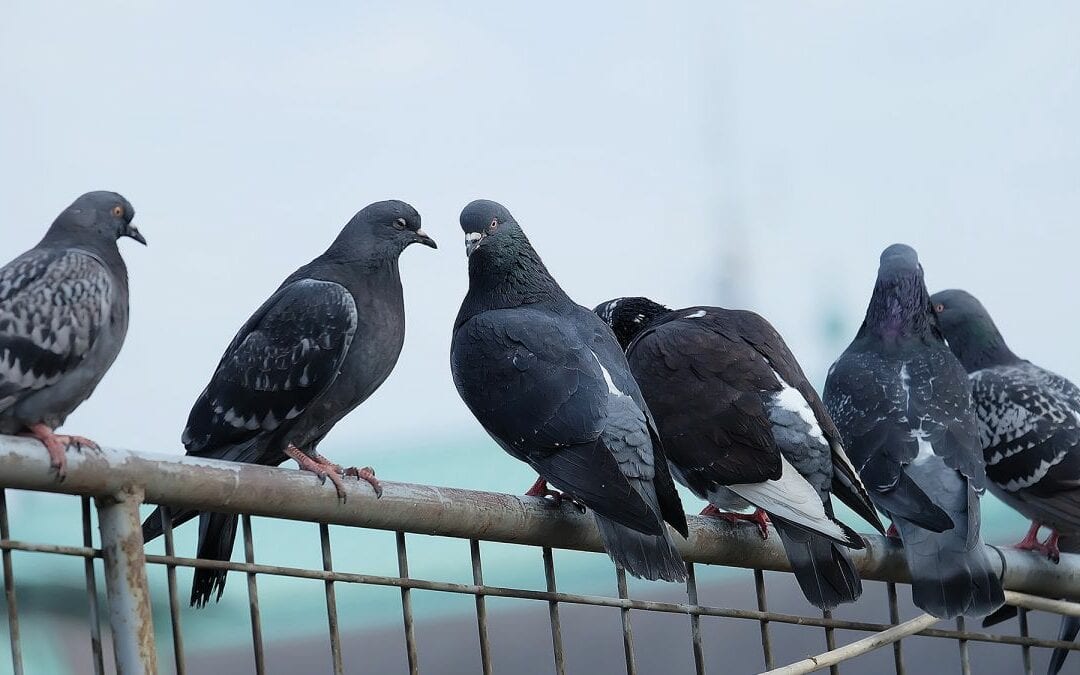
by Pigeon Patrol | Oct 3, 2023 | 4-S Gel Bird repellent, Animal Deterrent Products, Bird Deterrent Products, Bird Law, Bird Netting, Bird Spikes
PETA Supporters to Demand That Retailer Stop Cruel, Ineffective Trapping Program
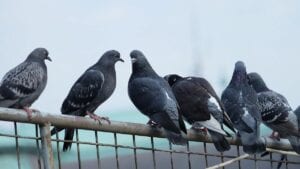
For Immediate Release:
September 6, 2018
Contact:
Brooke Rossi 202-483-7382
Los Angeles – What: Forever 21 has reportedly hired a contractor who has been trapping pigeons at its Los Angeles headquarters, prompting PETA supporters to plan to descend on the building on Friday to urge the retailer to stop trapping the birds immediately and instead take steps to make the area unappealing to them.
When: Friday, September 7, 2 p.m.
Where: Forever 21 Headquarters, 3880 N. Mission Rd. (at the intersection of N. Mission Road and Baldwin Street), Los Angeles
The pigeon problem appears to be related to a food truck that visits the company’s parking lot. PETA has attempted to work with Forever 21, offering myriad suggestions for peacefully coexisting with the birds and discouraging their presence, including simple measures such as keeping trash contained and secured and dumpsters locked, as well as barring workers and patrons from feeding the birds—but so far, it has refused to take these steps. Trapping initiatives actually backfire, because the resultant spike in the food supply accelerates breeding among survivors and inevitable newcomers, and populations then increase.
PETA—whose motto reads, in part, that “animals are not ours to abuse in any way”—points out that trapping initiatives cause animals immense suffering, as they can quickly succumb to stress, exposure, or injuries sustained in frantic attempts to escape.
“Forever 21’s decision to trap pigeons who are simply trying to eke out an existence is cruel, and such initiatives can tear wild families apart, leaving orphaned young to starve,” says PETA Executive Vice President Tracy Reiman. “PETA is calling on the retailer to nix this methodically cruel trapping and put into motion humane coexistence measures instead.”
Source
Pigeon Patrol
Pigeon Patrol Products & Services is the leading manufacturer and distributor of bird deterrent (control) products in Canada. Pigeon Patrol products have solved pest bird problems in industrial, commercial, and residential settings since 2000, by using safe and humane bird deterrents with only bird and animal -friendly solutions. At Pigeon Patrol, we manufacture and offer a variety of bird deterrents, ranging from Ultra-flex Bird Spikes with UV protection, Bird Netting, 4-S Bird Gel and the best Ultrasonic and audible sound devices on the market today.
Canada’s top wholesaler for bird deterrent products for twelve consecutive years.
Contact us at 1- 877– 4– NO-BIRD, (604) 585-9279 or visit our website at https://www.pigeonpatrol.ca/
Bird Gone, Pigeon Gone, Pigeon problems, pigeon spikes, 1-877-4NO-BIRD, 4-S Gel, Bird Control, Pigeon Control, bird repellent, Bird Spikes, sonic bird repellent, stainless steel bird spikes, bird spikes Vancouver, Ultra Sonic Bird Control, Bird Netting, Plastic Bird Spikes, Canada bird spike deterrents, Pigeon Pests, B Gone Pigeon, Pigeon Patrol, pest controller, pest control operator, pest control technician, Pigeon Control Products, humane pigeon spikes, pigeon deterrents, pigeon traps, Pigeon repellents, Sound & Laser Deterrents, wildlife control, raccoon, skunk, squirrel deterrent, De-Fence Spikes, Dragons Den, Pigeon, Pigeon Patrol, Pigeons Roosting, Vancouver Pigeon Control, Bird Spikes, Bird Control, Bird Deterrent, Pigeon Deterrent, Surrey Pigeon Control, Pest, Seagull deterrent Vancouver Pigeon Blog, Birds Inside Home De-fence, Pigeon Nesting, Bird Droppings, Pigeon Dropping, woodpecker control, Keep The Birds Away, Birds/rats, seagull, pigeon, woodpecker, dove, sparrow, pidgeon control, pidgeon problem, pidgeon control, flying rats, pigeon Problems, bird netting, bird gel, bird spray, bird nails, bird guard, Pigeon control, Bird deterrents, Pigeon deterrents, Bird control, solutions, Pigeon prevention, Pigeon repellent, Bird proofing, Pest bird management, Pigeon spikes, Bird netting, Humane bird control, Bird exclusion, Urban bird control, Anti-roosting devices, Pigeon removal, Bird barriers
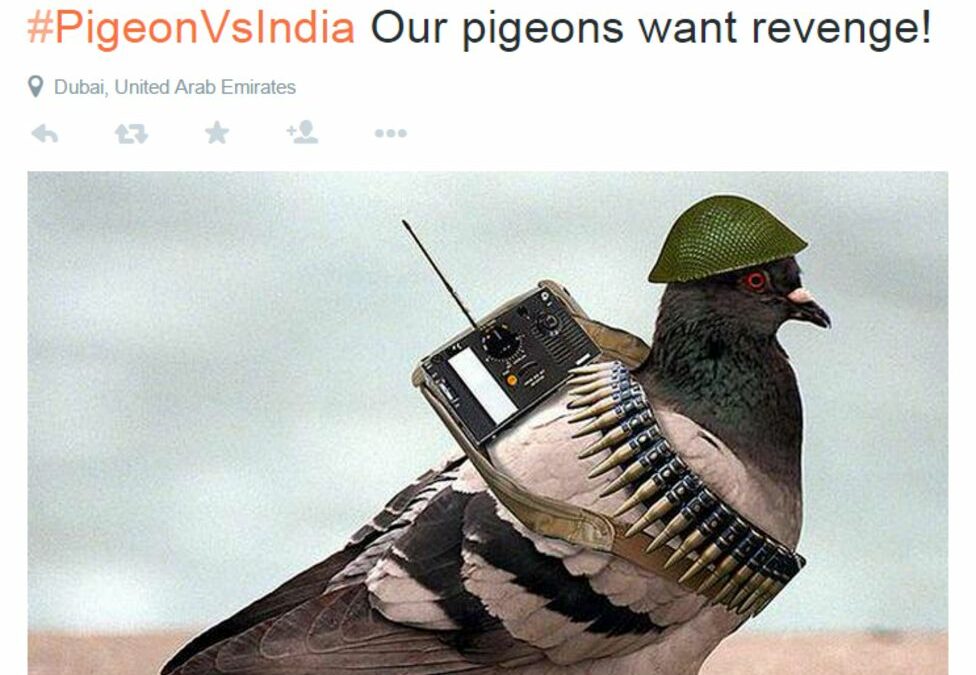
by Pigeon Patrol | Oct 3, 2023 | Bird Spike, Pigeon Predators, Pigeon Spikes, Pigeons, Pigeons in the News, Raccoons, Sparrows
A FALCON and a pigeon have been killed in Co Tyrone in what has been described as “one of the most serious incidents of peregrine persecution in Northern Ireland for several years”.
The PSNI were last night continuing to investigate after the birds were found dead at around 10pm in the Scraghey area, near Castlederg on July 10.
It is thought those behind the attack tied up the pigeon and covered it with poison, using it as bait to trap a peregrine falcon.
DUP MLA Jim Wells, also a member of the NI Raptor Study Group, described the incident as “cruel”.
“The vigilance of several members of the Raptor Study Group and the very quick response by the PSNI has revealed what is likely to be one of the most serious incidents of peregrine persecution in Northern Ireland for several years,” he told the Ulster Herald.
“The use of poison on a pigeon to kill a protected bird of prey is cruel, dangerous and totally irresponsible. The peregrine falcon once faced extinction due to the use of pesticides and now it’s recovery is threatened by those who seek to kill adults and young using totally illegal and reckless methods”.
He added:”The research has revealed that illegal prosecution remains a problem in some parts of the county. There are those who want to prevent people living in this area from seeing the fastest bird in the world”.
Source
Pigeon Patrol
Pigeon Patrol Products & Services is the leading manufacturer and distributor of bird deterrent (control) products in Canada. Pigeon Patrol products have solved pest bird problems in industrial, commercial, and residential settings since 2000, by using safe and humane bird deterrents with only bird and animal -friendly solutions. At Pigeon Patrol, we manufacture and offer a variety of bird deterrents, ranging from Ultra-flex Bird Spikes with UV protection, Bird Netting, 4-S Bird Gel and the best Ultrasonic and audible sound devices on the market today.
Canada’s top wholesaler for bird deterrent products for twelve consecutive years.
Contact us at 1- 877– 4– NO-BIRD, (604) 585-9279 or visit our website at https://www.pigeonpatrol.ca/
Bird Gone, Pigeon Gone, Pigeon problems, pigeon spikes, 1-877-4NO-BIRD, 4-S Gel, Bird Control, Pigeon Control, bird repellent, Bird Spikes, sonic bird repellent, stainless steel bird spikes, bird spikes Vancouver, Ultra Sonic Bird Control, Bird Netting, Plastic Bird Spikes, Canada bird spike deterrents, Pigeon Pests, B Gone Pigeon, Pigeon Patrol, pest controller, pest control operator, pest control technician, Pigeon Control Products, humane pigeon spikes, pigeon deterrents, pigeon traps, Pigeon repellents, Sound & Laser Deterrents, wildlife control, raccoon, skunk, squirrel deterrent, De-Fence Spikes, Dragons Den, Pigeon, Pigeon Patrol, Pigeons Roosting, Vancouver Pigeon Control, Bird Spikes, Bird Control, Bird Deterrent, Pigeon Deterrent, Surrey Pigeon Control, Pest, Seagull deterrent Vancouver Pigeon Blog, Birds Inside Home De-fence, Pigeon Nesting, Bird Droppings, Pigeon Dropping, woodpecker control, Keep The Birds Away, Birds/rats, seagull, pigeon, woodpecker, dove, sparrow, pidgeon control, pidgeon problem, pidgeon control, flying rats, pigeon Problems, bird netting, bird gel, bird spray, bird nails, bird guard, Pigeon control, Bird deterrents, Pigeon deterrents, Bird control, solutions, Pigeon prevention, Pigeon repellent, Bird proofing, Pest bird management, Pigeon spikes, Bird netting, Humane bird control, Bird exclusion, Urban bird control, Anti-roosting devices, Pigeon removal, Bird barriers










